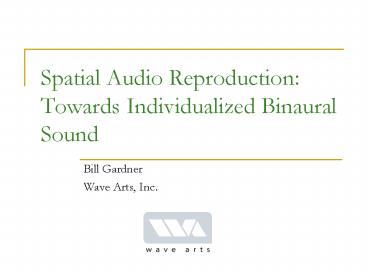Spatial Audio Reproduction: Towards Individualized Binaural Sound - PowerPoint PPT Presentation
1 / 23
Title:
Spatial Audio Reproduction: Towards Individualized Binaural Sound
Description:
Spatial hearing ... Based on non-linear properties of air. Tones inter-modulate at high intensity. Ultrasonic audio ... Discussed spatial audio reproduction techniques ... – PowerPoint PPT presentation
Number of Views:174
Avg rating:3.0/5.0
Title: Spatial Audio Reproduction: Towards Individualized Binaural Sound
1
Spatial Audio Reproduction Towards
Individualized Binaural Sound
- Bill Gardner
- Wave Arts, Inc.
2
Introduction
- Basic technologies for recording and reproducing
audio are mature - Compact disc (CD) reproduces audio signals at the
limits of human perception - Spatial audio reproduction remains a challenge
3
Overview
- Spatial audio reproduction
- Binaural audio via headphones
- Failed to live up to promise
- What can be done to fix
- Other spatial reproduction technologies
4
Binaural audio
- Recording or reproducing signals at the ears
- Binaural audio recorded and reproduced at your
own ears is stunningly realistic - Signals at two eardrums completely define
auditory experience - Goal is headphone system which is perceptually
indistinguishable from real listening
5
Spatial hearing
- Sound interacts with torso, head, external ears
and arrives at the two ear canals - Localization cues
- Time
- Amplitude
- Spectrum
- Dynamic cues
6
Head-Related Transfer Function (HRTF)
- Describes transformation of sound from free-field
to ear
7
HRTF azimuth dependency
8
HRTF elevation dependency
Concha
9
Concha reflection at 0 deg elevation
10
Concha reflection at 45 deg elevation
11
HRTFs from three humans
- External ears vary between humans
- High frequency cues are idiosyncratic
HRTFs provided by IRCAM
12
Binaural synthesis
- Measurement
- Synthesis
13
Perceptual validation
- Localization experiments
- Using individualized HRTFs
- Localization performance unchanged from real
listening (Wightman and Kistler, 1989) - Using non-individualized HRTFs
- Elevation errors
- Front/back reversals (Wenzel et al., 1993)
- Lack of externalization (sounds are perceived
near head or inside head)
14
Improving externalization
- Dynamic head tracking
- Artificial reverberation
15
Real/virtual discrimination tests
- Apparatus allows direct comparison of real and
virtual stimuli (Hartmann and Wittenberg, 1996) - Virtual stimuli can be modified to determine
limits of perception - Individualized HRTFs needed for externalization
16
How to obtain individualized HRTFs?
- Acoustic measurement impractical
- Would like fast, practical method
- Measurements of listener
- Based on image of head and ears
- Calibration procedure
17
Simplified head models
- Model torso and head using spheroids (Algazi and
Duda, 2002) - Model ear using simple shapes (Lopez-Poveda and
Meddis, 1996) - Models inaccurate at high frequencies
18
Statistical analysis
- Analyze sets of HRTFs to tease out low
dimensional models - PCA analysis of HRTFs (Kistler and Wightman,
1992) - 5 principal components sufficient to reproduce
individualized HRTFs - Parameters need to be determined for each
location and listener
19
Computational modeling
- Boundary element method (Kahana, 1998)
- 15,000 element model matches acoustical
measurements accurately to 15 kHz - Scanning head is difficult
20
Deformable head model?
- Start with refined head mesh model
- Obtain subjects measurements using computer
vision techniques - Morph mesh model to fit measurements
- Calculate HRTFs using computational acoustics
21
Crosstalk-cancelled audio
- Deliver binaural audio to listener via stereo
loudspeakers - Requires pre-processing to cancel crosstalk
- Works at low frequencies
- Listener must be fixed or tracked
22
Multichannel audio
- 5.1 and 7.1 surround systems developed for movie
theatres are now widely used in homes - Emphasis on frontal localization
- Doesnt require individualization
23
Ultrasonic audio
- Highly directional ultrasonic beam creates
audible sound (Pompei, 1999) - Based on non-linear properties of air
- Tones inter-modulate at high intensity
24
Ultrasonic audio
- 80 kHz and 81 kHz tones will produce audible 1
kHz difference tone - Requires pre-processing to reduce distortion
- Acceptable fidelity, poor low frequency response
25
Summary
- Discussed spatial audio reproduction techniques
- Binaural audio has promise for audio reproduction
indistinguishable from real listening - Requires individualized playback
- Proposed method to individualize playback for a
particular listener































